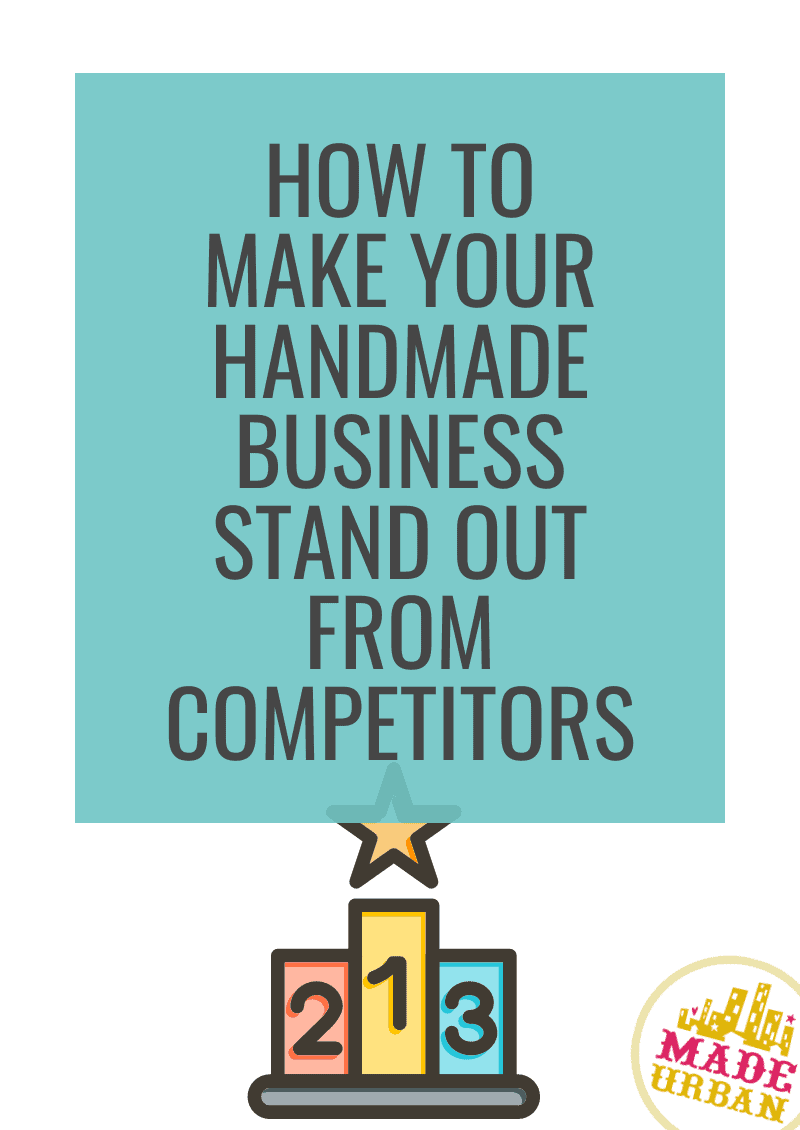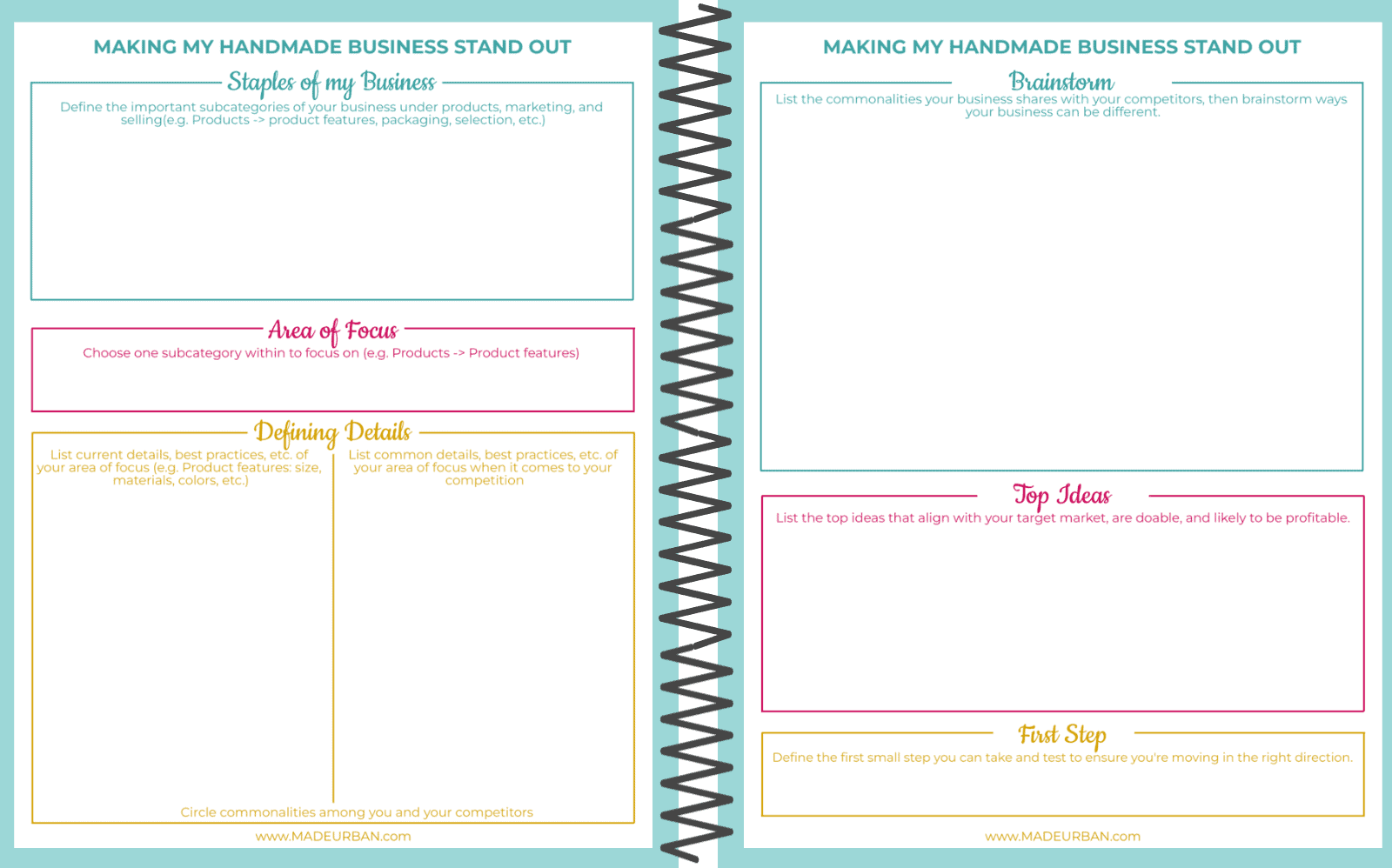How to Make your Handmade Business Stand Out from Competitors
We’re taught from a very young age to follow rules and fall in line so it’s no wonder we’re a little timid when it comes to questioning the rules, stepping outside the box and wanting to stand out.
My favorite story that teaches us the importance of thinking for ourselves is about a mother and a ham. Yes. A lot can be learned from ham 😉 There are several versions of the tale but the basics are:
A mother is cooking a ham and cuts the ends off before putting it in the pan. Her daughter asks why she cut the ends off and the mother replies because that’s what my mother always did. The daughter asks her grandmother why she cuts the ends off and she replies because that’s what my mother did. The daughter asks her great-grandmother why she cut the ends off and she explains that her pan was never big enough to fit the full ham.
Had the daughter not asked, this ritual of cutting the ends off would have continued to be passed down, wasting a perfectly good slice of meat and letting all the flavorful juices drip out during cooking 🙁
So when it comes to your business, it’s important to ask why things are done a certain way and if they need to be done that way.
Warm Up
To get your creative juices flowing and your mind primed to think outside the box, let’s try a fun exercise.
Look around the room and choose one object. How is this object the same as every other item of its kind and how could it be different?
- What do you wish the item could do?
- What are the issues you have with the item?
- What’s a staple feature of an object like that, that doesn’t need to be a staple?
Come up with 3 – 5 ideas to completely change it. They don’t need to make sense and you don’t have to worry about logistics. This is just to get you thinking outside of the box.
For example:
Common object: a coiled notebook
- What if it were a different shape?
- What if it didn’t use coils?
- What if you could do something with it besides tossing or storing it once it’s filled?
- What if I could create and adjust the dividers to suit your needs?
- What if you could store your laptop in it?
Next, brainstorm some answers. How would the object have to change to have a solution to your question?
For example:
- What fun shapes could notebooks come in?
- Which materials would make it more environmentally friendly?
- Maybe notebooks could be sold with a wick and wax so you could roll the notebook up once you’re done with it, dip it in melted wax and burn it as a candle.
Go as far as possible outside of the box to get your mind loosey-goosey for the next step.
STEP 1
Now let’s look at your handmade products and business.
Write down the main categories and subcategories of your business; what consumers notice and care about the most.
For example:
- Products – the way they’re made, the materials used, product features, product selection, where you source materials, the types of containers or boxes products are sold in, the way they’re wrapped after a sale, etc.
- Marketing – the type of content you post, when you post, platforms you use, etc.
- Selling – the design, functionality, copy, photos, etc. of your website, your customer service, your policies, the platforms you sell through, your sales techniques, your website design, your craft show display, etc.
Choose one category and one subcategory to focus on (to begin; you can come back and repeat these steps for more areas of your business).
For example, I may choose:
- Products (category)
- Product features (subcategory)
STEP 2
Define how you currently run that area of your business.
For example, if I’m exploring my products’ features (and I’m working with a handbag), I might define:
- Bag style
- Bag size
- Fabric
- Hardware
- Pockets
- Straps
Try to stick to details your target market cares about.
For example, if I’m targeting an eco-conscious market, they’re going to care most about the materials I use. They’ll likely also care about durability so it doesn’t end up in the landfill after a year of use. On the other hand, they may care less about the latest trends when it comes to the style of bag.
STEP 3
Now look at those details when it comes to your competition.
What’s the norm in your industry when it comes to an area of your products, marketing, or selling?
For example, I might go to Etsy and search for my bestselling bag to find what’s common among its product features.
If you’re focusing on your website design, what types of colors, fonts, photos, layout, checkout system, etc. are common on your competitors’ websites?
If you’re focusing on a marketing channel, what type of content do your competitors regularly post? Do they focus on photos or videos? How often do they post?
STEP 4
Where do you align with your competitors?
When looking at the areas you’ve defined in your business and in your competitors’ businesses, which areas are too similar?
Write down those commonalities.
STEP 5
Once you have similarities listed, swing your ideas in the opposite direction.
For example, if you checked out 5 of your competitor’s websites and they all use soft pastels, delicate fonts and are lacking personality, you may stand out by making your website bold and colorful with copy that might not appeal to everyone but definitely catches your ideal customer’s attention.
Keep your target market in mind, but get creative with your ideas.
If you were the consumer, what might you wish for? What might you be tired of? What would be shockingly different?
For example, let’s say I’m making eco-friendly bags and I notice that the colors I offer are similar to my competitors; earthtones. I may brainstorm ways I can play with colors, while keeping my bags eco-friendly. Naturally-dyed fabrics in bright colors, unique color combinations using earthtones, or adding fun phrases to the bags (e.g. “My eco-friendly bag is judging you”).
You also want to explore different segments of your target market or consider changing your target market altogether (if you don’t currently have a strong target market or customer base).
STEP 6
The last step is to analyze each idea and consider whether it’s a viable option to implement and if it will actually help your handmade business stand out.
It’s important to keep your ideal customer in mind.
- What do they care about the most?
- Will they care about the change?
- Is it still appealing to your target market?
You also want to consider how realistic the idea is to implement and if it will help your business generate more sales and be more profitable.
Before sinking a lot of time and money into a new idea, test your market. You might send a newsletter to your subscribers asking if they would be interested in the change. Or, make a prototype to test at your next craft show.
Start small (e.g. make a couple of new products, change a few elements on your website, spend a couple weeks trying a new marketing technique) and move in the direction your market is telling you to.
If sales go up, if time spent on your website goes up, if bounce rates lower, if engagement increases, etc. it’s a sign you’re moving in the right direction. Expand on that.
You can use a blank document to write your answers or download the free printable by clicking on the image below:
How does your handmade business or products stand out from the competitors? Tell me why shoppers choose your products over competitors in the comment section below.


Hey, I’m Erin 🙂 I write about small business and craft show techniques I’ve learned from being a small business owner for almost 2 decades, selling at dozens of craft shows, and earning a diploma in Visual Communication Design. I hope you find my advice helpful!



Hi Made Urban!! Thank you for a great article. I love the idea of thinking out of the box. My way of thinking out of the box, was to work with all of you at Made Urban. Because of Made Urban, I feel that I have completely stepped of my comfort zone. I have grateful for all that I have learned and put to good use. Keep up the great work.
Chris Cortese
Krazy Minds Designs
Hi Chris! Thanks so much for reading, glad you liked the article! We’re so happy that you joined our community to grow along with us. So great to hear you’re finding the advice helpful and are putting it to use!
Erin
Hi,
my name is Ms. Lemus, I would like to know, can I add a poster with my logo name and a pic. To make it stand out with a short note,
Saying how I my self created, my Accassaries Jewelry,